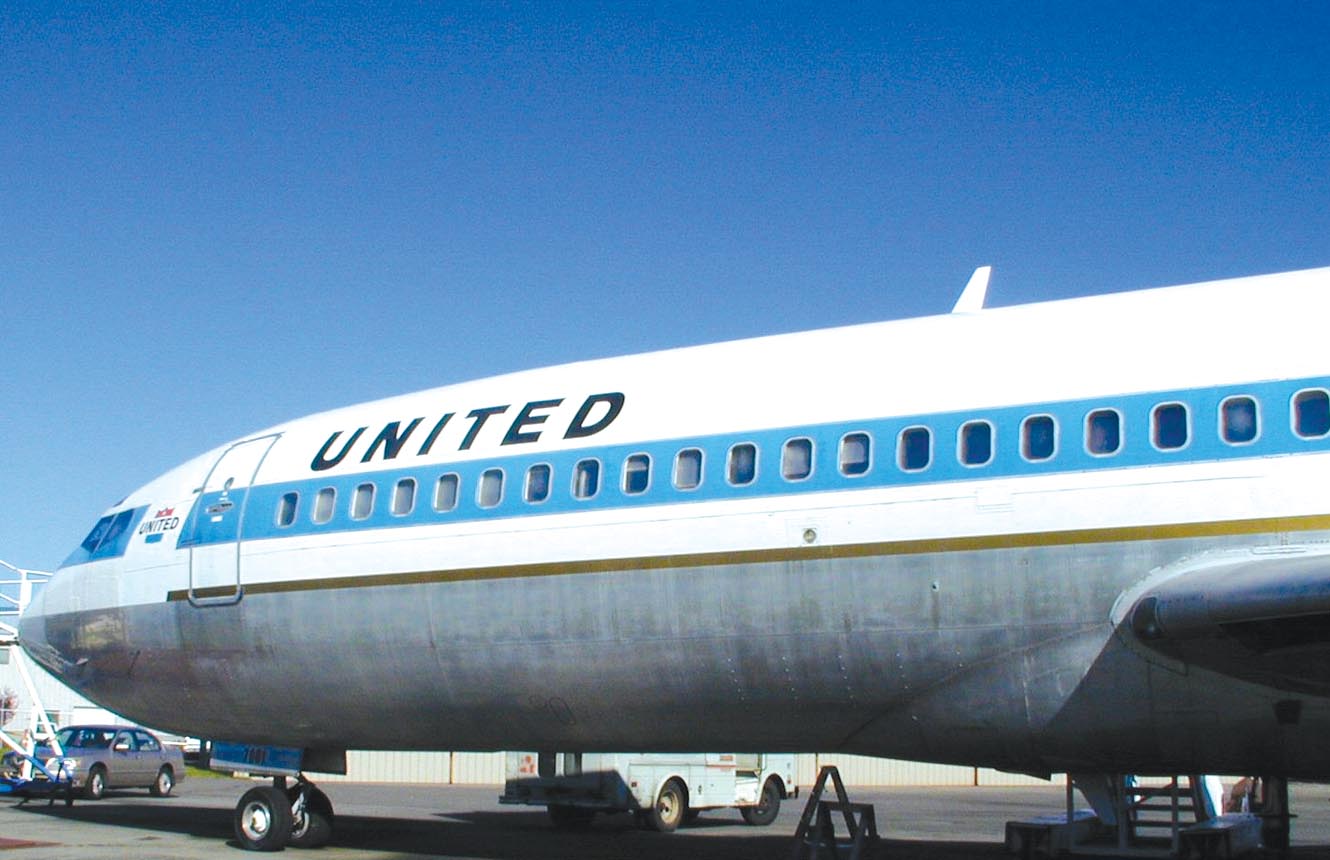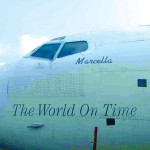The history of aviation is a history of firsts: humanity’s first flight, the first fighter plane, the first jet engine, the first passenger jet, and so on. The Museum of Flight is proud to honor these firsts in our collection and exhibits.
Some of the most important aviation firsts in the Pacific Northwest have been accomplished by Boeing Commercial Airplanes and are showcased in the museum’s airpark. America’s first jet “Air Force One” (a Boeing VC-137B), the prototype of the first 747 jumbo-jet, and the prototype of the world’s most popular airliner, the Boeing 737, share the airpark with the West Coast’s only Concorde and a Boeing-built American Airlines 727-200. With so many of the world’s most famous airliners, what more could the museum want? How about another first-the first-ever Boeing 727. Not to worry; we have that too!
The museum’s original 727, N7001U, is the first of 1,832 “three-holers” that were built at Boeing’s Renton plant. Known as “E1” in Boeing parlance, the jet was rolled out in Boeing test-center livery on Nov. 27, 1962. Its first flight on Feb. 9, 1963, took it from the Renton plant to Paine Field in Everett. Generally, Boeing keeps the first dedicated prototype of each model as a flight-test aircraft, but with the 727, they broke with tradition, delivering “E1” to United Airlines on Oct. 6, 1964.
Throughout its career, “E1” flew 64,495 hours, made 48,060 landings and carried more than three million passengers. This particular 727, which cost $4.4 million when it was purchased by United in 1964, earned its keep quite well, generating more than $300 million in revenue before its retirement in January 1991.
In 1984, while on a commercial flight aboard another aircraft, museum volunteer Bob Bogash saw “E1” taxiing by. He excitedly pointed out the world’s first 727 to a fellow passenger, who Bogash recalls being less than thrilled by this aviation history lesson. Luckily for The Museum of Flight, Bogash was undeterred by his seatmate’s lack of enthusiasm and became determined to acquire “E1” for the museum. Bogash, who was the director of quality assurance in the Material Division of Boeing Commercial Airplanes and the chairman of the aircraft acquisition committee for The Museum of Flight-at that time, a committee of one-approached top managers at United, asking for the airplane to be donated upon its retirement. They agreed, and on Jan. 13, 1991, the airplane-repainted in its original United colors-flew its last revenue trip from San Francisco to Seattle and was then ferried to Boeing Field for an acceptance ceremony at the museum. The last flight of “E1″took it to Paine Field, its final landing taking place on the same runway as its first.
Unfortunately for the museum (if understandably for a for-profit airline!), United cannibalized “E1” for parts for use as spares for the remaining fleet of 727s, leaving the museum with little more than the shell of an aircraft. All three engines were taken, as well as hundreds of smaller components both visible and “beneath the skin.” “E1” was left not only in un-airworthy condition, but un-display-worthy as well.
Upon his retirement from Boeing in 1995, Bogash decided to become even more involved with The Museum of Flight and volunteered to lead the restoration of “E1.” Bogash was no stranger to large aircraft preservation as he was involved in the restoration and preservation of the museum’s prototype 737 currently on display in the airpark. Once a month, come rain, shine, sleet or snow, Bogash traveled to Grant County International Airport in Moses Lake to run the 737’s engines and taxi it down the runway, in order to maintain the plane’s airworthiness until the airpark was built and the 737 could take its place of honor at the museum.
From this experience, as well as from his time at Boeing, Bogash knew that the restoration and preservation of a large aircraft can be broken down into four basic phases. Phase 1 is dedicated to the prevention of deterioration. This generally includes periodic washing and polishing of the aircraft as well as maintaining heated and de-humidified air within the plane. Phase 2 requires the restoration of missing hardware, which is where the “E1” project ran into problems, most notably with the three missing engines. Phase 3 generally involves fixing the hydraulics and air conditioning systems, along with the electrical power system. AC is especially important because it can be run as an aid in preserving the aircraft. Phase 4 is preparation for flight-in the case of “E1,” a possible one-time ferry flight back to Boeing Field.
The first year of restoration on the prototype 727 went well, with strides being made in both phase 1 and phase 3. The plane was washed and electrical work was completed, allowing for lights in the cabin, and a ground air conditioning unit is being used so that heated, de-humidified air can be pumped throughout the aircraft, preventing further deterioration. The equipment cooling and interior and exterior lighting is all currently functional on “E1.” Without more parts, however, work could not continue.
Bogash therefore spent the last nine years scrounging for 727 parts all over the world. The search seemed hopeless many times, and the museum accepted the 727-200 currently on display in the airpark from American Airlines in the belief that the restoration of E1 was stalled indefinitely. All this changed, however, when “Marcella” arrived at the museum’s restoration center in March of this year.
A former Eastern Airlines 727-100, “Marcella” (N124FE) spent her final years flying as a freighter for FedEx. While “Marcella” was undergoing an overhaul by Goodrich at Paine Field, FedEx decided that completing the work on the 37-year-old jet was not cost effective and therefore decided to donate the aircraft to the museum. “Marcella” is the third aircraft Bogash has negotiated with FedEx over the past few years, but it is the first that came with most of the parts necessary for the “E1” restoration project. FedEx has even promised the three engines needed to complete the United Airlines prototype, although they have not yet been delivered.
Finally work could continue on the 727 prototype. Bogash and his crew, primarily museum volunteers Terry Howard and Steve Huemoeller, have gotten back to work on “E1” with a vengeance. When “Marcella” first arrived, the main cabin was so full of extra parts the restoration crew had trouble opening the back door. The parts have since been sorted and “Marcella” has become an office of sorts for Bogash, Howard and Huemoeller. The men continue their work, excited that for the first time in many long years, their goal of restoring “E1” to flight status seems just a little bit closer. Currently the Keuger flaps, the main landing gear strut doors and the trailing edge flaps are being removed from “E1” and from “Marcella,” which will be followed by the installation of the donor parts on “E1.”
The ultimate future of “E1” is unclear at this time. Even if all the parts are found and replaced, will she ever be airworthy again? Boeing recently sent an AOG (aircraft on the ground) team to survey the aircraft and help the restorers assess the future flightworthiness of the 727 prototype. The results of the survey were very favorable. If “E1” is restored to flight status it could be displayed in the museum’s airpark in place of the current 727-200, which would move to Paine Field. Ultimately, the museum hopes to build a large commercial aviation wing on the site of the current airpark, and “E1” would certainly warrant a place of honor inside. In the interim, however, there is also discussion of possibly displaying “E1” outside the future National Flight Interpretive Center at Paine Field, a joint project among The Museum of Flight, the Boeing Tour Center and Snohomish County, due to open in 2005.
No one knows exactly what the future is for “E1,” but even if she never flies again, Bogash, Howard and Huemoeller are having a wonderful time fixing her up. Bogash put it best when he said, “The only difference between men and boys is that men have bigger toys.” These men will make sure that their “toy” will one day become another Museum of Flight first.
To find out more about the restoration of Boeing’s first 727 at The Museum of Flight Restoration Center, visit Bob Bogash’s unofficial but authoritative website at [http://www.rbogash.com/]; to join the restoration team, please e-mail him at bob@rbogash.com.















